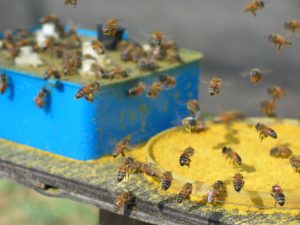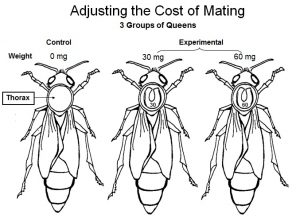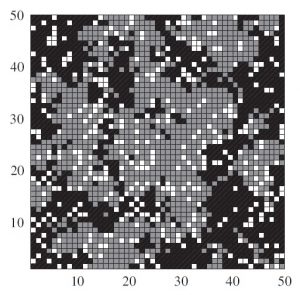Living in large societies, such as honey bee colonies, requires and allows for behavioral innovations. We are interested in how the complex division of labor among colony members evolves, how behavioral specialization is determined, and what consequences at the individual and colony level we can measure. Of particular interests are nursing and foraging behavior that have profound consequences for individual life history and colony demographics.
We have performed several studies in the context of the reproductive ground plan hypothesis, testing the links between reproductive traits and social behavior in multiple honey bee species at the phenotypic and genetic level. We have also studied the extreme polyandry of social insects, and honey bees in particular, from a theoretical and empirical perspective. We have also analyzed theoretical aspects of the evolution of cooperation and altruism.



Examples:
Ross C., Rychtar J., Rueppell O. (2015) A structured population model suggests that long life and post-reproductive lifespan promote the evolution of cooperation. Journal of Theoretical Biology, 369:85-94.
Rueppell O. (2014) The architecture of the pollen hoarding syndrome in honey bees: Implications for understanding social evolution, behavioral syndromes, and selective breeding. Apidologie, 45: 364-374.
Page R.E., Fondrk M.K., Rueppell O. (2012) Complex pleiotropy characterizes the pollen hoarding syndrome in honey bees (Apis mellifera L.). Behavioral Ecology and Sociobiology, 66: 1459-1466.
Graham, A.M., Munday, M.D., Kaftanoglu, O., Page R.E., Amdam G.V., Rueppell, O. (2011) Support for the reproductive ground plan hypothesis of social evolution and major QTL for ovary traits of Africanized worker honey bees (Apis mellifera L.). BMC Evolutionary Biology,11: 95
Gove R.P., Hayworth M. K., Chhetri M., Rueppell O. (2009) Division of labour and social insect colony performance in relation to task and mating number under two alternative response threshold models. Insectes Sociaux, 56: 319-331.
Hayworth M. K., Johnson N.G., Wilhelm M.E., Gove R.P., Metheny J.D., Rueppell O. (2009) Added weights lead to reduced flight behavior and mating success in polyandrous honey bee queens (Apis mellifera). Ethology, 115: 698-706.
Rueppell O., Hunggims E., Tingek S. (2008) Association between larger ovaries and pollen foraging in queenless Apis cerana workers supports the reproductive ground – plan hypothesis of social evolution. Journal of Insect Behavior, 21: 317-321.
Rueppell O., Johnson N., Rychtar J. (2008) Variance-based selection may explain general mating patterns in social insects. Biology Letters, 4: 270-273.
Rüppell O., Pankiw T., Page R.E. (2004) Pleiotropy, epistasis and new QTL: the genetic architecture of honey bee foraging behavior. Journal of Heredity, 95: 481-491.